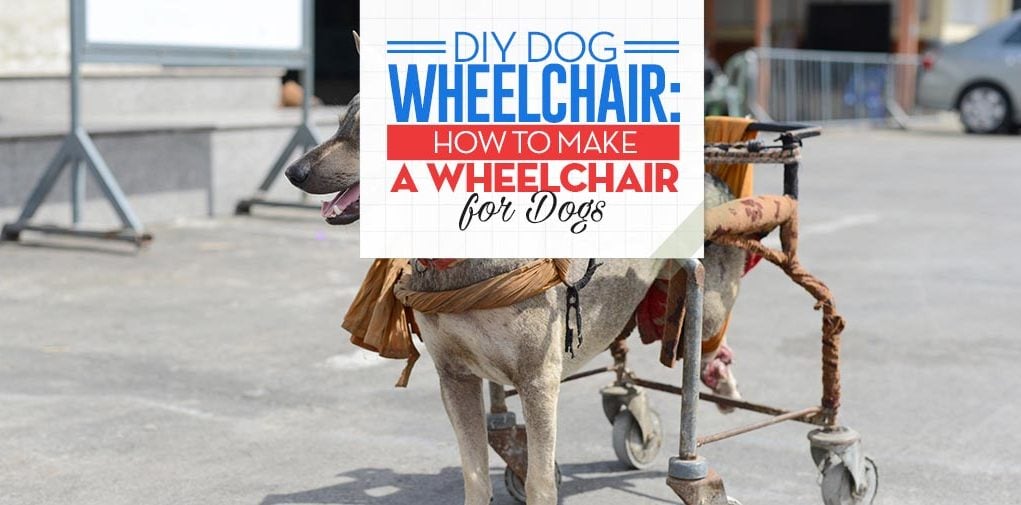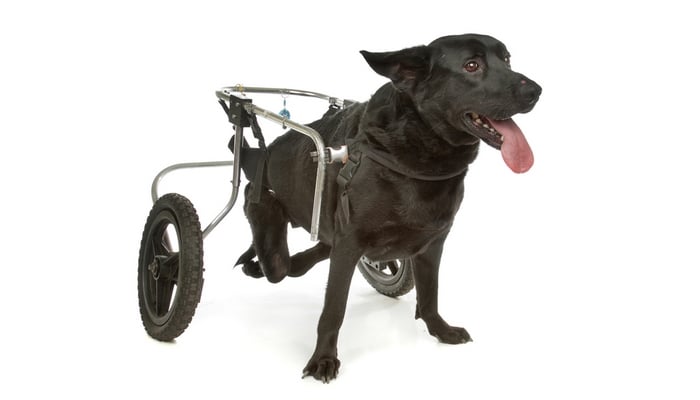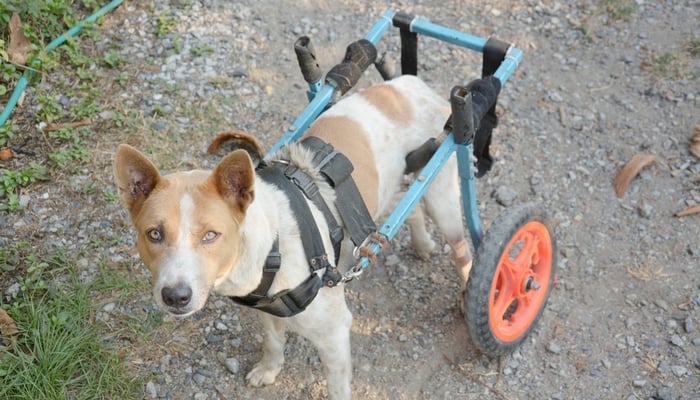Dogs, just like humans, occasionally need wheelchairs. This could be due to an injury, rehabilitation of limbs, arthritis, neurological issues or something as simple as old age. A DIY dog wheelchair helps your pet move around freely and provide him with a sense of normality which life without a chair may not.
With the right type of store bought dog wheelchair or DIY dog wheelchair, you won't need to worry about your dog's comfort. For dogs who have been frustrated by their inability to walk, they often have a surprisingly fast adjustment to using a wheelchair. You may find that your dog is up and running around in a matter of minutes!
However, dogs who have partial use of limbs tend to take longer and require shorter sessions in the beginning to allow them to get them comfortable with the idea of the chair. Stairs can of course be tricky in a doggy wheelchair, but, depending on your dog’s confidence, going down a few stairs down can be a painless and even fun experience! If you’ve ever taken to the streets on a bicycle, you’ll know that a step or two is just a matter of committing to the challenge.
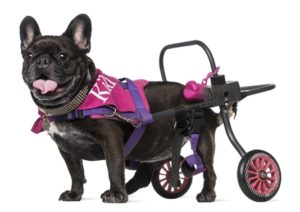 Any more than two or three stairs, and you will need to help your dog to avoid any injuries. Luckily, your pooch has built in self preservation and is unlikely to attempt more than a few stairs by himself.
Any more than two or three stairs, and you will need to help your dog to avoid any injuries. Luckily, your pooch has built in self preservation and is unlikely to attempt more than a few stairs by himself.
Going up stairs is a different ball-game. Just like trying to get a pet stroller up stairs, you often need help. Stairs can be quite a frustrating experience for your dog, especially for those that can get down one or two stairs only to be trapped and unable to navigate back up the stairs.
If your home has a layout with a number of stairs, you might consider investing in a ramp to allow your dog easier access. A DIY dog wheelchair can only go so far – it's not going to be able to give your dog the 100% mobility that he used to have before his injury.
However, a wheelchair will allow your dog to gain most of his mobility back, and it will keep him active and healthy. Depending on your dog's strength and overall health condition, it is likely that he'll still be able to enjoy many of the activities that he did before being confined to the chair. Whether it's short daily walks or a game of fetch, your vet will be able to tell you if your dog is up to the challenge.
PODCAST: Intervertebral Disc Disease in Dogs
DIY Dog Wheelchair
how to make a wheelchair for dogs all by yourself
Dog's Mobility Issues That May Require a Dog Wheelchair
There are a number of reasons why your pet may need a DIY dog wheelchair. From old age to accidental injuries, you never know when you may need this invaluable piece of equipment.
Some of the issues that may require you to purchase or make a wheelchair for your dog include:
1. Arthritis
A common issue among the human and canine population, living with advanced arthritis can be painful from day to day. Merely the pressure of your dog’s own body weight on his affected limbs may be too much.
In this situation, your dog’s mobility may be severely limited, but as luck would have it a DIY dog wheelchair has been proven to make a huge difference. Not to mention, it can drastically improve their quality of life.
2. Amputations
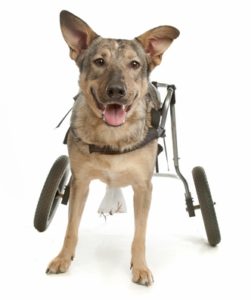 We hate to think that a serious injury and amputation could ever happen to our pet, however, if the worst does happen – a wheelchair can be the perfect companion and will help your pup to regain his independence.
We hate to think that a serious injury and amputation could ever happen to our pet, however, if the worst does happen – a wheelchair can be the perfect companion and will help your pup to regain his independence.
Many dogs who have suffered from depression post-surgery have become their bright, bubbly selves once introduced to the freedom which a wheelchair can provide.
3. Recovery/Rest post surgery
This is perhaps one of the most efficient uses of a DIY dog wheelchair. There are many reasons that our canines can require surgery, from routine operations to lifesaving procedures. Resting a dog after his surgery can be quite the challenge, especially with more vivacious pups! A wheelchair is a useful tool to speed up recovery and rehabilitation.
4. Neurological Issues
Neurological issues affecting your dog's ability to move can often be aided by a wheelchair. Depending on the severity of the condition, legs may need stirrups for protection. In cases of less severity, and where you vet recommends strengthening the limbs, the chair can be lowered to provide limbs with minimal access the ground.
Features That A Pet Wheelchair Needs To Have
When considering getting a wheelchair for dogs, whether buying from a store or making your own DIY dog wheelchair, there are a few essentials the wheelchair needs and these requirements can change depending on your dog’s condition. For dogs with no use of their front or back limbs, they will need to be fully supported and ideally have a wheelchair made-to-measure.
For dogs with partial use of their limbs, they will need a quad-chair which can be adjusted to provide different levels of support and complete freedom of the legs movement while touching the ground. It is important to make sure you get the right wheelchair for your dog's condition. Allowing your pup not only to be comfortable but also give them a full range of motion.
You have the option of building a two-wheeled chair or a quad chair.
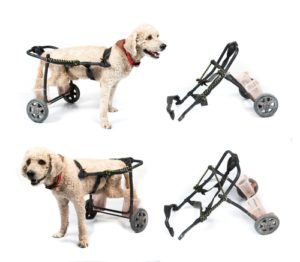 A two-wheeled chair is designed to provide your dog support on either the front or back end. These are designed to be weightless on the shoulders, while fully supporting the weight of your pet.
A two-wheeled chair is designed to provide your dog support on either the front or back end. These are designed to be weightless on the shoulders, while fully supporting the weight of your pet.
When you think of a dog’s wheelchair you always imagine the hind legs being supported, but what if the front legs require support and not the back? Luckily for you, a two-wheeled chair is designed to help your dog on either the front or back legs.
If your dog needs support on his front legs, this results in him having a slightly harder time adapting to his new wheels. However, when your dog masters his new wheelchair the results are just as good as any rear-end wheelchair!
Quad chairs offer support to dogs with a weakness in all four limbs. These can be very useful for rehabilitation after surgery as you can adjust the level of assistance the chair provides. They allow the legs of your pet to touch the ground and use a full range of motion for gradual and safe recovery.
RELATED: Top 7 Best Dog Wheelchairs for Rehabilitation
Will Lifting My Dog In And Out Not Hurt Him?
 Good quality wheelchairs for dogs are designed to be as supportive and comfortable as possible. This goes for you being able to comfortably remove and attach the wheels.
Good quality wheelchairs for dogs are designed to be as supportive and comfortable as possible. This goes for you being able to comfortably remove and attach the wheels.
Depending on your dog's condition, you are wise to worry about it hurting him, and as always in these situations – it is best to err on the side of caution and be as gentle as possible each time you place him into and out of his wheelchair.
To do this, you should first make sure that your dog is in a part of your home they find comfortable. Keep them calm and happy when you lift him/her out of their wheelchair by taking it slow and practicing this so that they become accustomed to it. Lots of praise and love is always going to help.
I Have A Huge Dog. Can A Wheelchair Work For Him?
Wheelchairs work just as well for dogs as they do humans. Just like a child using a wheelchair is perfectly supported, as is their adult counterpart, and so too is a canine.
It is just a matter of making sure you get the right wheelchair for the job. Most good quality commercial wheelchairs for dogs will have everything a large dog needs as well, but they can sometimes be difficult to find. Therefore, going the DIY wheelchair for dogs route may not only be better, but also the only option you have left.
Support is everything when it comes to these chairs, and yes, even a dog of 240 lbs. is going to be able to find a wheelchair perfectly designed for him and his requirements, but it will take time for you to pick the right one, since they are far less popular than dog wheelchairs for small dogs or medium sized breeds.
To start off, here's a great video on DIY dog wheelchair (explanations below):
How To Measure Your Dog For A Wheelchair
We’ve already covered the fact that a custom, made-to-measure saddle chair is best for your dog. So, the next step is to make sure you get the right measurements to guarantee a smooth and comfortable ride in your DIY dog wheelchair.
Here are the key areas you need to measure for that perfect fit:
- Back height from hip to floor
- Length from shoulder blades to base of tail
- Inside distance from heels of front feet to toes of back feet
- Chest all the way around just behind the front leg
- Front height, from top of shoulders to floor
- Width of shoulders, straight measurement not curved around
- Width of hips, straight measurement not curved around
- Groin to the floor
Measuring a dog for a wheelchair is similar in several ways to measuring him for a dog harness for proper fit. Here's a video and step-by-step guide on how to measure a dog.
Making Your Own DIY Wheelchair for Dogs
Choosing the right kind of canine wheelchair to fit your dog’s requirements and lifestyle is essential. So, the first question to ask is – Does he need full support or partial support? This decision will define which kind of chair you'll be making.
Also, the bigger the dog, the stronger and larger the wheelchair needs to be. Bear this in mind when choosing the materials for your DIY dog wheelchair project. Make sure to measure accordingly. You don’t want his front legs dangling off the ground because you got the measurements wrong.
You will need to take into consideration whether your dog is at his mature height and weight. If he isn’t, you have two choices, either build a new wheelchair in the future or build an adjustable chair now.
Supplies You’ll Need
Here is a list of tools and items you will need to construct your very own doggy wheelchair:
- Saw to cut piping
- Piping (material dependent on dog weight and size)
- Fabric to create a saddle
- Dog harness to help secure the wheelchair to your dog
- Wheels (size appropriate)
Step 1: Build The Frame
First, you need to construct your frame. You’re most likely going to be using PVC piping for this project, and the easiest way to build your frame will be a mixture of glue and ‘PVC T’s to create the ideal shape.
Remember when constructing your frame that no part of the structure should rub on your dog as that could cause sores or discomfort.
Step 2: Wheels
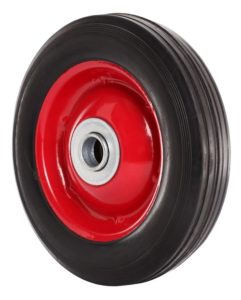 As your frame is constructed from piping, adding wheels is relatively straightforward. Drill some holes in your piping to allow for your wheels to be attached securely with a nut and bolt. Make sure your wheels move freely but provide solid support and do not wobble.
As your frame is constructed from piping, adding wheels is relatively straightforward. Drill some holes in your piping to allow for your wheels to be attached securely with a nut and bolt. Make sure your wheels move freely but provide solid support and do not wobble.
If your dog loves the outdoors, you might want to consider some wheels that have more grip and won’t slip in wet and muddy fields.
Step 3: Create The Saddle
Depending on your skill level, you might want to construct a padded saddle frame using piping to provide your dog with the ideal support; while allowing for bathroom activities. This also comes with the benefit of there being less chance of sores and discomfort from a fabric based saddle.
If that’s beyond your skill level – a fabric based saddle is the next best thing – you will want to cut holes in the saddle for your dog's legs and making sure to provide as much support to your dog's pelvic area as possible. You should be able to attach this to your frame either with some sewing mastery or cable ties.
Step 4: Attach The Harness
Your harness should not result in the wheelchair being supported by your dog's shoulders. This is merely a device to ensure the wheelchair stays attached to your dog and to aid with maneuverability. You don’t want your dog to run off and leave his wheelchair behind due to a poor fit.
Securing this with the harnesses existing loops is ideal as you will avoid any chafing or unnecessary bulk, which again, could cause sores to develop.
Step 5: Test It Out
The best part of making your own DIY wheelchair is the ability to modify it to your dog's needs. For example, if it’s too tall – you can saw it down to size! It’s important to get this right for your dog as this is his means of not only transportation, but exercise, and freedom too.
The only way you’ll know for sure is to test it and see how it fares and if your dog has any problems adjust accordingly. Remember, if you can’t get a perfect result for your dog – there are plenty of specialists who can help you with a custom build that will be perfect for your pooch!
RECOMMENDED: 8 Tips On How To Keep Your Senior Dog Active
Other Dog Supplies for Disabled Dogs You Might Need
With your dog running around happy in his wheelchair, you might find there are a few other items that you can use to aid in his comfort. Here are some suggestions to add a little more luxury to your dog’s wheelchair life!
Diapers
If your dog is being supported by a fabric (soft) saddle, then you might find a handy hack is to utilize doggy diapers to keep your harness and dog clean and comfortable. This makes for a very quick clean up at the end of the day and helps provide a little more padding to your dog’s behind too!
Boots
Running around on wheels sounds like great fun, but depending on your dog’s front paws he might need a little extra support to make sure they stay as healthy as they can. Boots for dogs are an excellent way to ensure your dog's legs get a little-added support as well as a great way to prevent future injury.
Final Thoughts
 The entire process of deciding on the type of chair your dog needs, measuring him, and ultimately building his wheelchair can be a quick and I hasten to add – inexpensive process!
The entire process of deciding on the type of chair your dog needs, measuring him, and ultimately building his wheelchair can be a quick and I hasten to add – inexpensive process!
If your pooch could benefit from a little extra mobility, why not take half a day next weekend, and build him a DIY dog wheelchair?! If you happen to know someone that has a pooch in need, do your bit to make his and his owners lives easier, and volunteer to help them build their own chair.
I have on many occasions seen owners of paralysed dogs trying to do their best with limited resources – and many times, they had never even heard of a wheelchair for dogs. So, spread the word, and let’s let all dog’s enjoy the freedom of mobility no matter what their physical issues may be.


